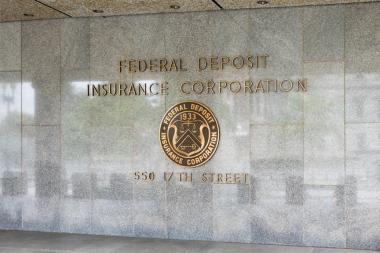What We Do

The mission of the Federal Deposit Insurance Corporation (FDIC) is to maintain stability and public confidence in the nation's financial system. In support of this goal, the FDIC:
- Insures deposits,
- Examines and supervises financial institutions for safety and soundness and consumer protection,
- Works to make large and complex financial institutions resolvable, and
- Manages receiverships.
An independent agency of the federal government, the FDIC was created in 1933 in response to the thousands of bank failures that occurred in the 1920s and early 1930s. Learn more about the history of the FDIC.
The FDIC receives no Congressional appropriations - it is funded by premiums that banks and savings associations pay for deposit insurance coverage. The FDIC insures trillions of dollars of deposits in U.S. banks and thrifts - deposits in virtually every bank and savings association in the country.
Deposit Insurance
The standard insurance amount is $250,000 per depositor, per insured bank, for each account ownership category. Since the start of FDIC insurance on January 1, 1934, no depositor has lost a penny of insured funds as a result of a failure. The FDIC's Electronic Deposit Insurance Estimator can help you determine if you have adequate deposit insurance for your accounts. The FDIC insures deposits only. It does not insure securities, mutual funds, or similar types of investments that banks and thrift institutions may offer. Learn more about deposit insurance.
Supervision & Examination
The FDIC directly supervises and examines more than 5,000 banks and savings associations for operational safety and soundness. Banks can be chartered by the states or by the Office of the Comptroller of the Currency. Banks chartered by states also have the choice of whether to join the Federal Reserve System. The FDIC is the primary federal regulator of banks that are chartered by the states that do not join the Federal Reserve System. In addition, the FDIC is the back-up supervisor for the remaining insured banks and savings associations.
The FDIC also examines banks for compliance with consumer protection laws, including the Fair Credit Billing Act, the Fair Credit Reporting Act, the Truth in Lending Act, and the Fair Debt Collection Practices Act, to name a few. Finally, the FDIC examines banks for compliance with the Community Reinvestment Act, which requires banks to help meet the credit needs of the communities they were chartered to serve.
Resolutions
To protect insured depositors, the FDIC responds immediately when a bank or savings association fails. Institutions generally are closed by their chartering authority - the state regulator or the Office of the Comptroller of the Currency. The FDIC has several options for resolving institution failures, but the most common is to sell the deposits and loans of the failed institution to another institution. Customers of the failed institution automatically become customers of the assuming institution. Most of the time, the transition is seamless from the customer's point of view.
Where We Are
The FDIC is headquartered in Washington, DC, and has established regional and field offices around the country.
Who We Are
The FDIC is managed by a five-person Board of Directors that includes the Comptroller of the Currency and the Director of the Consumer Financial Protection Bureau, all of whom are appointed by the President and confirmed by the Senate, with no more than three being from the same political party.
For more information about the FDIC’s mission and operations, please be sure to browse the additional information offered in the About section of this website.
Thank you for your interest in the FDIC.
